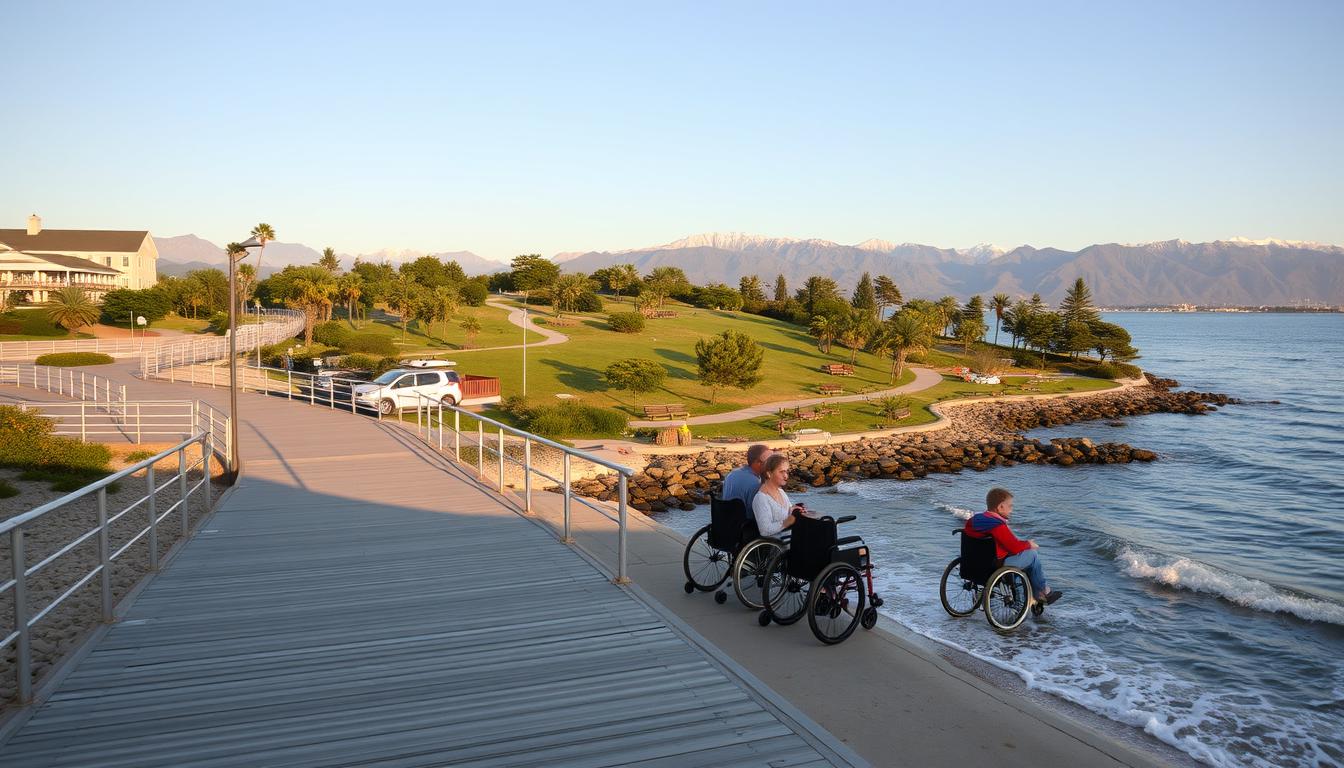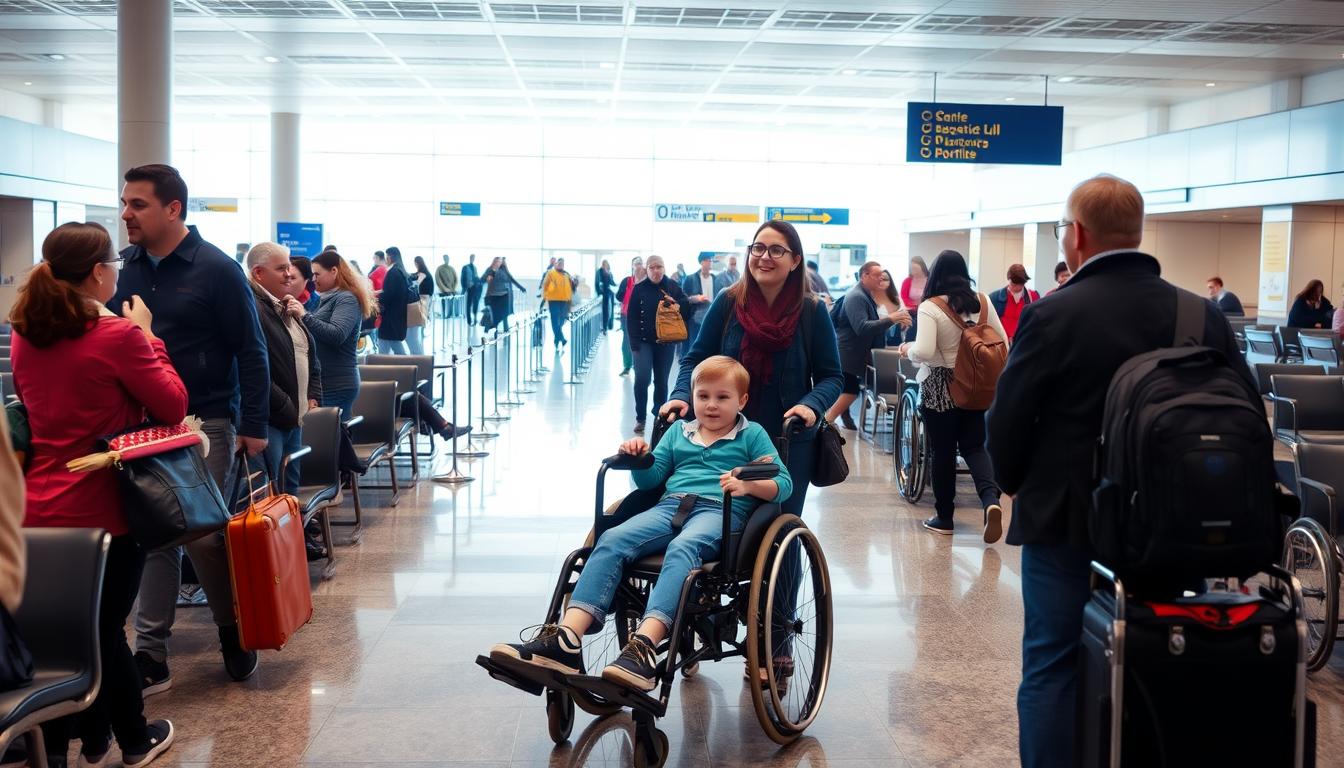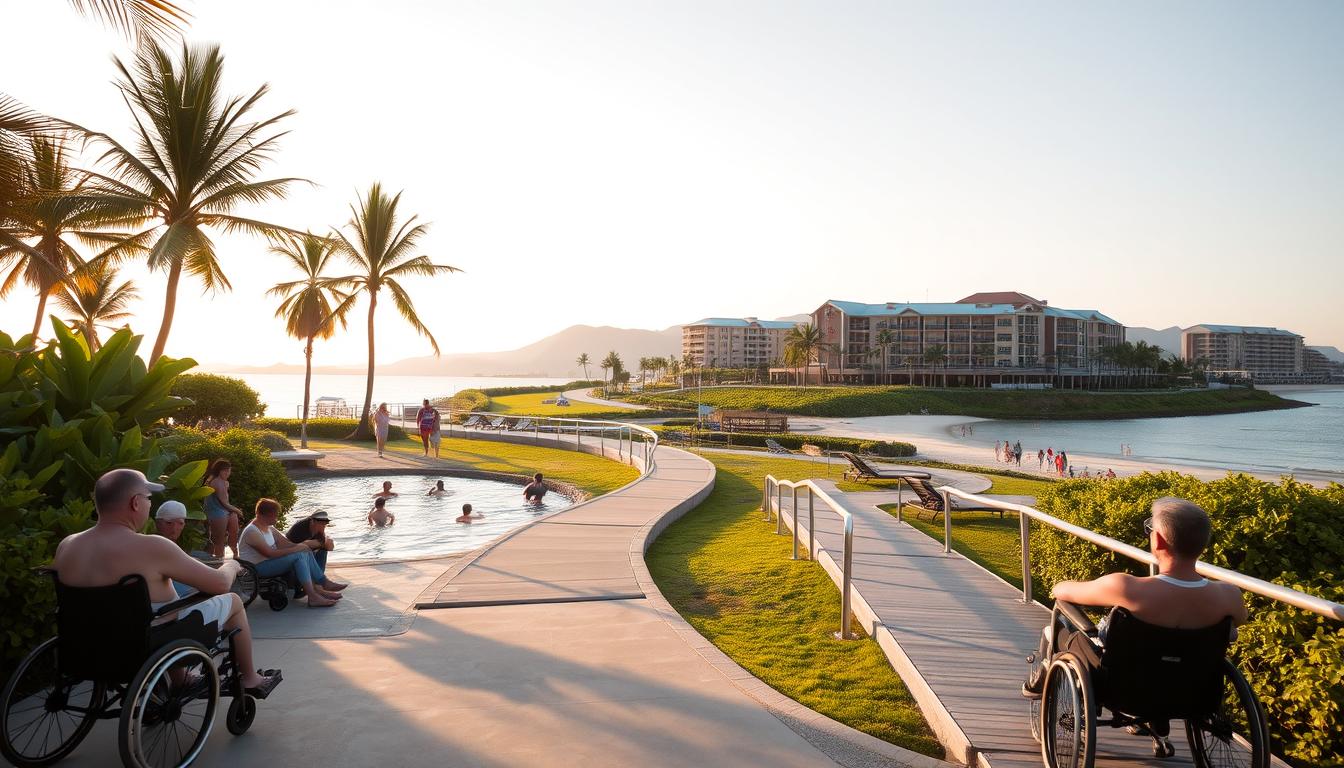Did you know over 61 million adults in the United States live with a disability? Many are eager to explore the world. Planning a handicapped-friendly holiday can seem tough, but with the right help, you can have a great trip.
The travel industry is now providing more inclusive options. You can find many accommodations, transportation, and activities for travelers with disabilities.
Understanding the need for accessible travel is key. By using the resources available, you can make your trip memorable and fun. In this article, we’ll show you how to plan a handicapped-friendly holiday. We’ll cover choosing the right places to stay and popular destinations.
Key Takeaways
- Understanding the importance of accessible travel
- Types of accessible accommodations available
- Transportation solutions for travelers with disabilities
- Popular destinations that cater to travelers with disabilities
- Tips for planning a stress-free handicapped-friendly holiday
Understanding the Importance of Accessible Travel
Traveling is a universal language. It lets everyone, no matter their abilities, join in the global conversation. As the travel world grows, it’s clear that accessible travel is key, not just a small part.
Benefits of Traveling for Individuals with Disabilities
Traveling is a chance for people with disabilities to grow and learn. It lets them explore new cultures and meet others. Inclusive travel experiences help them feel independent and confident.
Some big benefits include:
- More social interaction and community feeling
- Seeing new places and trying new things
- Growing as a person
Social and Mental Health Benefits
Traveling can deeply affect social and mental health. It helps people with disabilities feel less alone and more connected. Accessible travel also offers a chance to relax and reduce stress.
Travel is known to lower stress and improve mood. By making travel options for disabled individuals available, the travel industry helps mental health.
Economic Impact on the Travel Industry
The economic benefits of accessible travel are big. It opens a large and growing market for businesses. Inclusive travel experiences can increase revenue and help a business grow.
Some key economic benefits are:
| Economic Benefits | Description |
|---|---|
| Increased Revenue | Accessible travel options attract new customers, boosting sales. |
| Market Expansion | Travel for people with disabilities can help a business reach more people. |
| Competitive Advantage | Businesses that focus on accessibility stand out from others. |
Types of Accessible Accommodation
Accessible accommodations are key for a great handicapped-friendly holiday. They offer many options to fit different needs. This ensures a stay that’s both comfortable and enjoyable.
Hotels That Cater to Handicapped Guests
Many hotels now have rooms and facilities for guests with disabilities. They include roll-in showers, grab bars, and lowered counters. Some even offer wheelchair rentals or help with transferring.
When booking a hotel, look for those certified as accessible. Check if they have a program for guests with disabilities. Reading reviews from others with similar needs can also help.
Vacation Rentals with Accessibility Features
Vacation rentals offer more space and flexibility than hotel rooms. They’re great for travelers with disabilities. Many highlight features like wide doorways and adapted bathrooms.
When searching for a vacation rental, use filters for accessibility. Contact the manager or owner to confirm the features. This ensures they meet your needs.
Accessible Camping and Glamping Options
Accessible camping and glamping let you enjoy nature without giving up comfort. Many campsites have adapted facilities like accessible restrooms and picnic areas.
Glamping options, like safari tents or yurts, offer luxury. Research the site’s accessibility features and amenities before planning. This ensures your trip meets your needs.
Transportation Solutions for Travelers with Disabilities
For travelers with disabilities, finding the right transportation is key to a great trip. There are many options to meet different needs. This ensures everyone can travel easily and on their own.
Accessible Public Transit Options
Many cities are working hard to make public transit better for everyone. You’ll find buses and trains that are easy to get into, and audio announcements for those who can’t see. Use transit apps to plan your trip and find the best routes.
Key Features to Look for in Public Transit:
- Ramps or lifts for wheelchair access
- Audio announcements for visually impaired travelers
- Braille signage for stations and stops
- Priority seating for travelers with disabilities
Rentable Mobility Equipment at Airports
Airports offer mobility equipment for rent to help travelers with disabilities. You can find wheelchairs, electric carts, and more to help you get around. Always call your airline ahead of time to book what you need.
| Equipment Type | Description | Availability |
|---|---|---|
| Manual Wheelchairs | Standard wheelchairs for navigating the airport | Widely available |
| Electric Carts | Motorized carts for longer distances or mobility issues | Available upon request |
| Wheelchair Strollers | Strollers with wheelchair accessibility for families | Available at some airports |
Benefits of Accessible Car Rentals
Accessible car rentals give you the freedom to travel whenever you want. Many companies have cars with ramps or lifts for people with disabilities. This way, you can see places without being tied to public transit times.
Tips for Renting an Accessible Vehicle:
- Book your vehicle well in advance to ensure availability
- Specify your needs when making the reservation
- Inspect the vehicle upon pickup to ensure it meets your requirements
Popular Handicapped-Friendly Destinations
There are many places now that welcome travelers with disabilities. These spots focus on making everyone feel included. They have made big changes to meet different needs.
Major Cities with Accessibility Features
Big cities worldwide have worked hard on making things accessible. Places like New York, London, and Tokyo have wheelchair-friendly transport and attractions. You can visit museums, landmarks, and events without any hassle.
Beach Resorts That Welcome All Guests
Beach resorts are now open to everyone. They offer accessible beach wheelchairs and ramps. Places like Maui in Hawaii and San Diego in California are great for inclusive beach fun.
National Parks and Nature Destinations
Nature lovers with disabilities can enjoy the outdoors. Parks like Yellowstone and Yosemite have paved trails and accessible restrooms. They make sure everyone can see nature’s beauty.
When you plan your next trip, think about these places. They’re perfect for city adventures, beach days, or nature walks. There’s a handicapped-friendly spot for you.
Planning Ahead for Your Trip
Planning a trip well can change everything for people with disabilities. It can turn a stressful trip into a fun vacation. To make your holiday enjoyable and accessible, follow a few key steps.
Researching Accessible Locations
Start by researching your destination to see if it’s accessible. Look at the accessibility of attractions, public transport, and places to stay. Websites and travel blogs have great tips and reviews from others with disabilities.
Also, check out accessible tour companies. They offer special experiences for travelers with disabilities, tailored to their needs.
Making Reservations for Accessible Services
After finding places and services, book them. Look for hotels or rentals with features like ramps and wide doors. These make your stay easier.
When booking, tell airlines, tour operators, and others about your needs. This helps them prepare for you.
Preparing Your Travel Documents
Getting your travel documents ready is important. Make sure you have your passport, visas, travel insurance, and medical records. These are essential for your trip.
Carry a doctor’s letter about your condition and needs. It’s useful in emergencies.
Useful Travel Apps and Resources
Planning a trip? There are many digital tools to help. You can find your way around, discover places that are easy to get to, and meet others who travel like you.
Apps for Accessibility Information
Many travel apps offer accessibility info. This makes planning easier. Here are some top picks:
- AccessNow: It gives detailed info on places worldwide.
- Wheelmap: Users rate and review places like restaurants and museums.
- Google Maps: It helps find accessible routes and spots.
Websites for Finding Handicapped-Friendly Locations
There are also great websites for finding places that are easy to get to. Check out these sites:
- Accessible Travel Solutions: It has info on travel options, like where to stay and how to get around.
- MobilityInternational: Offers tips and a list of places that are easy to visit.
Online Communities and Support Groups
Meeting others who travel can be really helpful. Online groups let you share tips, ask questions, and learn from others. Here are some good ones:
- Disabled Travelers Forum: A place to share travel stories and get advice.
- Accessible Travel Groups on Social Media: Groups on social media share tips and resources.
Using these apps and resources can make your trip better. You’ll find info on accessibility, places to visit, and communities to connect with. It’s all about making your travel experience better.
Activities and Experiences for Everyone
Now, many places offer activities for all visitors. This change makes sure everyone can enjoy their holiday, no matter their abilities.
Adaptive Sports and Recreational Opportunities
Destinations are adding adaptive sports and activities for people with disabilities. You can try accessible skiing, adaptive cycling, and wheelchair-friendly water sports. These activities are fun and let you connect with the local area.
Some top adaptive sports include:
- Paralympic sports
- Adaptive rock climbing
- Hand cycling
- Wheelchair tennis
Accessible Tours and Sightseeing Options
Seeing new places is a big part of any trip. Luckily, many spots have accessible tours and sightseeing options for everyone. You can find tours with sign language, audio descriptions, or touch experiences for the blind.
| Attraction | Accessibility Features | Location |
|---|---|---|
| The Grand Canyon | Wheelchair-accessible viewpoints, audio descriptions | Arizona, USA |
| Statue of Liberty | Accessible pathways, elevators, sign language interpretation | New York, USA |
| Yellowstone National Park | Accessible trails, wheelchair rentals, audio descriptions | Wyoming, USA |
Adding these accessible activities to your trip plans makes sure everyone has a great time.
Dining Out: Finding Accessible Restaurants
Accessible dining is key for a fun vacation for those with disabilities. Knowing where to find restaurants that meet your needs can make your trip better.
Identifying Key Features in Restaurants
When looking for accessible restaurants, there are important things to check. These include:
- Wheelchair-accessible entrances: Ramps or flat entrances for easy wheelchair access.
- Adapted restrooms: Restrooms with grab bars, lowered sinks, and enough space for wheelchairs.
- Accessible seating: Tables and areas that are easy to get to and can fit wheelchairs.
- Visual menus: Menus that are easy to read, like digital ones or those with big print.
Looking for these features can make your dining out more enjoyable and stress-free.
Popular Chains Known for Accessibility
Some restaurant chains work hard to be more accessible. Here are a few:
| Restaurant Chain | Accessibility Features |
|---|---|
| Starbucks | Wheelchair-accessible entrances, adapted restrooms, and digital menus. |
| McDonald’s | Many have wheelchair ramps, accessible restrooms, and some digital menus. |
| Chili’s | Offers wheelchair-accessible entrances and restrooms, with some adapted seating areas. |
These chains are known for their efforts to welcome more customers.
It’s smart to call ahead or check the website before dining out. This way, you can make sure the restaurant meets your needs for a great dining experience.
Traveling with a Caregiver or Companion
Traveling with a caregiver or companion can make a big difference for people with disabilities. It helps make the trip enjoyable and stress-free. This support is key to a good holiday.
Selecting the Right Professional Help
Choosing the right caregiver or companion is important. They should understand your needs and provide the right support. Professional caregivers can help with personal care and medical needs while you travel.
To find the right help, look for:
- Experience in caring for people with disabilities
- Knowledge of accessible travel options and destinations
- Good communication skills
Tips for Communicating Needs
Good communication is essential for a great trip. When you travel with a caregiver or companion, make sure to share your needs and preferences. This ensures you get the support you need.
Here are some tips for communicating your needs:
- Be clear and specific about what you need, including medical or personal care.
- Talk about your travel plans with your caregiver or companion. This helps them know your schedule and any special needs at each place.
- Plan how to communicate, like how to reach you or how you like to get information.
By following these tips and choosing the right help, you can have a more inclusive travel experience. This will make your holiday better and meet your needs.
Budgeting Your Handicapped-Friendly Holiday
Planning ahead can make your handicapped-friendly holiday affordable. Adaptive travel solutions are now more available. This lets you enjoy holidays for handicapped people without spending too much.
When budgeting for your trip, know the costs of accessible travel. This includes transportation, where you stay, and activities that fit your needs.
Identifying Grants and Financial Resources
Many groups offer grants and help for people with disabilities to travel. Looking into these can cut down your costs.
- Government programs
- Non-profit organizations focused on disability support
- Corporate social responsibility initiatives
Affordable Options for Accessible Travel
Choosing budget-friendly options for accessible travel can help. Think about:
- Accessible vacation rentals
- Public transportation with accessibility features
- Free or discounted attractions for people with disabilities
By using these tips, you can have a great holiday that’s accessible and won’t break the bank.
Safety Tips for Traveling with Disabilities
Traveling with a disability requires preparation and knowledge of accessible resources. It’s important to plan ahead to stay safe and enjoy your trip.
Emergency Plans for Travelers
Having an emergency plan is key for travelers with disabilities. Know the emergency exits, have a plan for medical emergencies, and carry important medical info.
- Research the emergency services available at your destination.
- Carry a personal identification card with your medical conditions and emergency contact information.
- Know the nearest hospital or medical facility that can accommodate your needs.
Personal Safety Tips for Accessibility
There are also personal safety tips to enhance your travel. Being aware of your surroundings and having the right equipment can make a big difference.
| Safety Measure | Description | Benefit |
|---|---|---|
| Carrying a portable charger | Ensures your devices remain charged. | Stay connected in case of an emergency. |
| Using accessible transportation | Choose transportation services that cater to your needs. | Reduces the risk of accidents or difficulties during travel. |
| Staying informed | Research your destination and stay updated on local conditions. | Helps in avoiding potentially hazardous situations. |
By following these safety tips and being prepared, you can enjoy a more secure and enjoyable trip. Remember, your safety is the most important thing. With the right planning, you can have a fulfilling travel experience.
Travel Insurance Options for Handicapped Travelers
Travel insurance is key for holiday planning for people with disabilities. It offers financial security and peace of mind. Unexpected events can happen while traveling, and the right insurance can help a lot.
Knowing how important travel insurance is is the first step to a worry-free trip. It can cover many unexpected situations, like trip cancellations or medical emergencies.
Importance of Travel Insurance
Travel insurance is very important for people with disabilities. It acts as a financial safety net for unexpected events. This way, you won’t face big expenses unexpectedly.
- Trip cancellations or interruptions due to medical reasons
- Medical emergencies or evacuations
- Loss or damage to mobility equipment
- Travel delays or missed connections
Specific Coverages for Disabilities
Some travel insurance policies have special coverages for people with disabilities. These include coverage for mobility equipment, help with medical evacuations, and more.
| Coverage Type | Description | Benefit |
|---|---|---|
| Mobility Equipment Coverage | Covers loss, damage, or theft of mobility aids | Up to $5,000 |
| Medical Evacuation | Covers costs associated with emergency medical evacuations | Up to $100,000 |
| Trip Cancellation | Covers trip cancellations due to medical reasons | Up to $10,000 |
When picking a travel insurance policy, check the specific coverages. Make sure they fit your needs. This way, you can enjoy your holiday without worrying about unexpected events.
Sharing Your Travel Experience
As you explore wheelchair-friendly holiday spots and accessible vacation destinations, consider sharing your journey with others. By doing so, you can inspire fellow travelers and help create a more inclusive travel community.
Documenting Your Journey
Writing and blogging about your travel experiences can be a great way to share tips and recommendations with others. You can detail your favorite accessible vacation destinations, highlighting the features that made them stand out.
Spreading Awareness on Social Media
Using social media platforms to share your travel stories can reach a wider audience. By posting about your experiences at wheelchair-friendly holiday spots, you can help raise awareness and promote accessible tourism.
Your stories can make a significant difference in helping others plan their trips and feel more confident in their travel choices.




